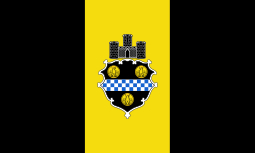Carnegie Mellon University
Carnegie Mellon University (CMU) is a private research university based in Pittsburgh, Pennsylvania. Founded in 1900 by Andrew Carnegie as the Carnegie Technical Schools, the university became the Carnegie Institute of Technology in 1912 and began granting four-year degrees. In 1967, the Carnegie Institute of Technology merged with the Mellon Institute of Industrial Research, formerly a part of the University of Pittsburgh, to form Carnegie Mellon University.[8] With its main campus located 3 miles (5 km) from Downtown Pittsburgh, Carnegie Mellon has grown into an international university with over a dozen degree-granting locations in six continents, including campuses in Qatar and Silicon Valley, and more than 20 research partnerships.[9]
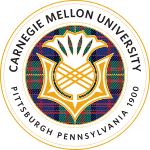 | |
Former names | Carnegie Technical Schools (1900–1912) Carnegie Institute of Technology (1912–1967) Carnegie-Mellon University (1968–1988) |
|---|---|
| Motto | "My heart is in the work" (Andrew Carnegie) |
| Type | Private university |
| Established | 1900 by Andrew Carnegie 1967 (merger with Mellon Institute) |
| Endowment | $2.54 billion (2019)[1] |
| Chairman | Jim Rohr[2] |
| President | Farnam Jahanian |
| Provost | James Garrett |
Academic staff | 1,483 (March 2020)[3] |
| Students | 14,799 (Fall 2019)[4] |
| Undergraduates | 7,022 (Fall 2019)[4] |
| Postgraduates | 7,777 (Fall 2019)[4] |
| Location | , , United States |
| Campus | Urban, 140 acres (57 ha)[5] |
| Colors | Cardinal, Black, Grey, and White |
| Athletics | NCAA Division III UAA, ACHA, IRA 17 varsity teams[6] |
| Nickname | Tartans |
| Mascot | Scotty the Scottish Terrier[7] |
| Website | www |
The university has seven colleges and independent schools, all of which offer interdisciplinary programs: the College of Engineering, College of Fine Arts, Dietrich College of Humanities and Social Sciences, Mellon College of Science, Tepper School of Business, H. John Heinz III College of Information Systems and Public Policy, and the School of Computer Science.[10][11]
Carnegie Mellon counts 14,799 students from 117 countries, over 109,000 living alumni, and over 1,400 faculty members.[12] Past and present faculty and alumni include 20 Nobel Prize laureates, 13 Turing Award winners, 23 Members of the American Academy of Arts and Sciences, 22 Fellows of the American Association for the Advancement of Science, 79 Members of the National Academies, 124 Emmy Award winners, 47 Tony Award laureates, and 10 Academy Award winners.[13]
Institutional formation
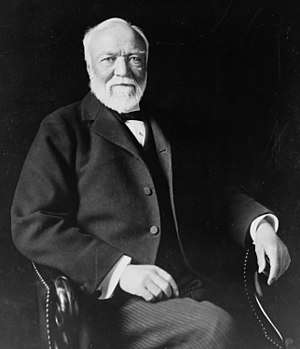
The Carnegie Technical Schools were founded in 1900 in Pittsburgh[14] by the Scottish American industrialist and philanthropist Andrew Carnegie, who wrote the time-honored words "My heart is in the work", when he donated the funds to create the institution. Carnegie's vision was to open a vocational training school for the sons and daughters of working-class Pittsburghers (many of whom worked in his mills). Carnegie was inspired for the design of his school by the Pratt Institute in Brooklyn, New York founded by industrialist Charles Pratt in 1887.[15] In 1912, the institution changed its name to Carnegie Institute of Technology (CIT) and began offering four-year degrees. During this time, CIT consisted of four constituent schools: the School of Fine and Applied Arts, the School of Apprentices and Journeymen, the School of Science and Technology, and the Margaret Morrison Carnegie School for Women.
The Mellon Institute of Industrial Research was founded in 1913 by banker and industrialist brothers Andrew Mellon (who went on to become U.S. Treasury Secretary) and Richard B. Mellon in honor of their father, Thomas Mellon, patriarch of the Mellon family. The Institute began as a research organization which performed work for government and industry on a contract and was initially established as a department within the University of Pittsburgh. In 1927, the Mellon Institute incorporated as an independent nonprofit. In 1937, the Mellon Institute's iconic building was completed and it moved to its new, and current, location on Fifth Avenue.[16]
In 1967, with support from Paul Mellon, Carnegie Tech merged with the Mellon Institute of Industrial Research to become Carnegie Mellon University. Carnegie Mellon's coordinate women's college, the Margaret Morrison Carnegie College closed in 1973 and merged its academic programs with the rest of the university.[17]

The industrial research mission of the Mellon Institute survived the merger as the Carnegie Mellon Research Institute (CMRI) and continued doing work on contract to industry and government. CMRI closed in 2001 and its programs were subsumed by other parts of the university or spun off into autonomous entities.[18]
Campus
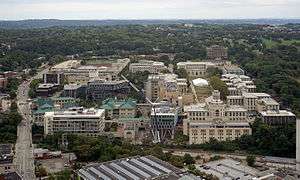
Carnegie Mellon's 140-acre (57 ha)[5] main campus is three miles (5 km) from downtown Pittsburgh, between Schenley Park and the Squirrel Hill, Shadyside, and Oakland neighborhoods. Carnegie Mellon is bordered to the west by the campus of the University of Pittsburgh. Carnegie Mellon owns 81 buildings in the Oakland and Squirrel Hill neighborhoods of Pittsburgh.
For decades the center of student life on campus was "Skibo Hall", the University's student union. Built in the 1950s, Skibo Hall's design was typical of Mid-Century Modern architecture, but was poorly equipped to deal with advances in computer and internet connectivity. The original Skibo was razed in the summer of 1994 and replaced by a new student union that is fully wi-fi enabled. Known as University Center, the building was dedicated in 1996. In 2014, Carnegie Mellon re-dedicated the University Center as the Cohon University Center in recognition of the eighth president of the university, Jared Cohon.[19]
A large grassy area known as "the Cut" forms the backbone of the campus, with a separate grassy area known as "the Mall" running perpendicular. The Cut was formed by filling in a ravine (hence the name) with soil from a nearby hill that was leveled to build the College of Fine Arts building.
The northwestern part of the campus (home to Hamburg Hall, Newell-Simon Hall, Smith Hall, and Gates Hillman Complex) was acquired from the United States Bureau of Mines in the 1980s.
In 2006, Carnegie Mellon Trustee Jill Gansman Kraus donated the 80-foot (24 m)-tall sculpture Walking to the Sky, which was placed on the lawn facing Forbes Ave between the Cohon University Center and Warner Hall. The sculpture was controversial for its placement, the general lack of input that the campus community had, and its (lack of) aesthetic appeal.[20]
In April 2015, Carnegie Mellon University, in collaboration with Jones Lang LaSalle, announced the planning of a second office space structure, alongside the Robert Mehrabian Collaborative Innovation Center, an upscale and full-service hotel, and retail and dining development along Forbes Avenue. This complex will connect to the Tepper Quadrangle, the Heinz College, the Tata Consultancy Services Building, and the Gates-Hillman Center to create an innovation corridor on the university campus. The effort is intended to continue to attract major corporate partnerships to create opportunities for research, teaching, and employment with students and faculty.[21]
Campus architecture and design
The campus began to take shape in the Beaux-Arts architecture style of Henry Hornbostel, a winner of the 1904 competition to design the original institution and later the founder of what is now the Carnegie Mellon School of Architecture.
There was little change to the campus between the first and second World War. A 1938 master plan by Githens and Keally suggested acquisition of new land along Forbes Avenue, but the plan was not fully implemented. The period starting with the construction of the Hall of the Arts (former Graduate School of Industrial Administration) building (1952) and ending with Wean Hall (1971) saw the institutional change from Carnegie Institute of Technology to Carnegie Mellon University. New facilities were needed to respond to the University's growing national reputation in artificial intelligence, business, robotics and the arts. In addition, an expanding student population resulted in a need for improved facilities for student life, athletics and libraries. The campus finally expanded to Forbes Avenue from its original land along Schenley Park. A ravine long known as "The Cut" was gradually filled in to campus level, joining "the Mall" as a major campus open space.
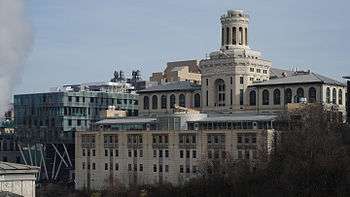
The buildings of this era reflect current attitudes toward architectural style. The International Style, with its rejection of historical tradition and its emphases on functionalism and expression of structure, had been in vogue in urban settings since the 1930s. It came late to the Carnegie campus because of the hiatus in building activity and a general reluctance among all institutions of higher education to abandon historical styles. By the 1960s, it was seen as a way to accomplish the needed expansion and at the same time give the campus a new image. Each building was a unique architectural statement that may have acknowledged the existing campus in its placement, but not in its form or materials.
During the 1970s and 1980s, the tenure of University President Richard Cyert (1972–1990) witnessed a period of growth and development. The research budget grew from roughly US$12 million annually in the early 1970s to more than US$110 million in the late 1980s. The work of researchers in new fields like robotics and software engineering helped the university to build on its reputation. One example of this approach was the introduction of the university's "Andrew" computing network in the mid-1980s. This pioneering project, which linked all computers and workstations on campus, set the standard for educational computing and established Carnegie Mellon as a leader in the use of technology in education and research. On April 24, 1984, cmu.edu, Carnegie Mellon's Internet domain became one of the first six .edu domain names.
Present
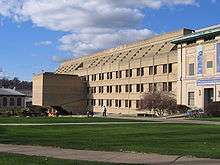
In the 1990s and into the 2000s, Carnegie Mellon solidified its status among American universities, consistently ranking in the top 25 in the national U.S. News & World Report rankings, and in the top 60 (ranking 55th in 2013) amongst universities worldwide.[23][24] Carnegie Mellon is distinct in its interdisciplinary approach to research and education. Through the establishment of programs and centers that are outside the limitations of departments or colleges, the university has established leadership in fields such as computational finance, information systems, cognitive sciences, management, arts management, product design, behavioral economics, energy science and economics, human-computer interaction, entertainment technology, and decision science. Within the past two decades, the university has built a new university center (Cohon University Center), theater and drama building (Purnell Center), business school building (Posner Hall), student union and several dormitories. Baker Hall was renovated in the early 2000s (decade), and new chemistry labs were established in Doherty Hall soon after. Several computer science buildings, such as Newell Simon Hall, also were established, renovated or renamed in the early 2000s (decade). The university has most recently completed building the Gates Hillman Complex and continues renovating historic academic and residence halls.

The Gates Hillman Complex, opened for occupancy on August 11, 2009, sits on a 5.6-acre (2.3 ha) site on the university's West Campus, surrounded by Cyert Hall, the Purnell Center for the Arts, Doherty Hall, Newell-Simon Hall, Smith Hall, Hamburg Hall and the Robert Mehrabian Collaborative Innovation Center. It contains 318 offices as well as labs, computer clusters, lecture halls, classrooms and a 255-seat auditorium. The Gates Hillman Complex was made possible by a $20 million lead gift from the Bill & Melinda Gates Foundation and an additional $10 million grant from the Henry L. Hillman Foundation. The Gates Hillman Complex and the Purnell Center for the Arts are connected by the Randy Pausch Memorial Footbridge.[25]
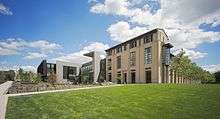
On April 15, 1997, Jared L. Cohon, former dean of the Yale School of Forestry & Environmental Studies, was elected president by Carnegie Mellon's Board of Trustees. During Cohon's presidency, Carnegie Mellon continued its trajectory of innovation and growth. His strategic plan aimed to leverage the University's strengths to benefit society in the areas of biotechnology and life sciences, information and security technology, environmental science and practices, the fine arts and humanities, and business and public policy. In 2006, following negotiations between President Cohon and South Australian Premier Mike Rann, CMU opened a campus of the Heinz College in the historic Torrens Building in Adelaide, Australia. President Cohon's term ended on June 30, 2013, after which he returned to the faculty at Carnegie Mellon.
On July 1, 2003, Carnegie Mellon launched "Insp!re Innovation", a $1 billion comprehensive fundraising campaign. Half of the campaign goal is intended for the endowment to provide long-lasting support for faculty, students and breakthrough innovations. The campaign brought in a total of $1.19 billion, with $578.5 million going toward Carnegie Mellon's endowment. It also enabled the university to establish 31 endowed professorships, 97 endowed fellowships and 250 endowed scholarships.[26] On September 7, 2011, William S. Dietrich II, the former chairman of Dietrich Industries, Inc., a subsidiary of Worthington Industries, Inc., pledged a gift of $265 million, effective on October 6, 2011, upon his death. In response to this gift, Carnegie Mellon renamed the College of Humanities and Social Sciences as the Marianna Brown Dietrich College of Humanities and Social Sciences after William Dietrich's mother.[27]
New York's Mayor Michael R. Bloomberg, and New York University's President John Sexton on April 23, 2012, announced an agreement between New York City, New York's MTA, and a consortium of academic institutions, and private technology companies, that will lead to the creation in New York of a Center for Urban Science and Progress (CUSP). The Center for Urban Science and Progress (CUSP) is an applied science research institute which will be a partnership of institutions from around the globe, led by New York University with a consortium of universities including the University of Warwick, Carnegie Mellon University, the City University of New York, the Indian Institute of Technology Bombay, and the University of Toronto.
In September 2012, Carnegie Mellon announced the construction of the Sherman and Joyce Bowie Scott Hall on the Pittsburgh campus. The new building is situated between Hamerschlag Hall, Roberts Hall, and Wean Hall and houses the university-wide Wilton E. Scott Institute for Energy Innovation, a new nanotechnology research center, the Institute for Complex Engineered Systems, and the Biomedical Engineering Department.[28] Further, in November 2013, Carnegie Mellon announced a $67 million gift from David Tepper, who previously donated $56 million, to develop the Tepper Quadrangle on the north campus. The Tepper Quad includes a new Tepper School of Business facility across Forbes Avenue from a renovated and expanded Heinz College[29] as well as other university-wide buildings and a welcome center which serves as a public gateway to the university.[30] Alongside the Tepper Quad and Hamburg Hall, Carnegie Mellon will construct an innovation center with a $35 million gift from Tata Consultancy Services which will partner with Carnegie Mellon to develop technology and business solutions.[31]
On February 5, 2013, Carnegie Mellon announced the selection of Subra Suresh, Director of the National Science Foundation and Dean of the Massachusetts Institute of Technology School of Engineering, as its ninth president effective July 1, 2013.[32] Suresh stepped down in June 2017[33] and was replaced by Farnam Jahanian, the university's interim-president and former provost, in March 2018.[34]
Academics
Rankings
| University rankings | |
|---|---|
| National | |
| ARWU[35] | 40 |
| Forbes[36] | 37 |
| THE/WSJ[37] | 25 |
| U.S. News & World Report[38] | 25 |
| Washington Monthly[39] | 89 |
| Global | |
| ARWU[40] | 95 |
| QS[41] | 51 |
| THE[42] | 27 |
| U.S. News & World Report[43] | 82 |
Nationally, U.S. News & World Report ranks Carnegie Mellon tied for 25th among American research universities in 2019.[44] Several of its graduate programs have been ranked in national and international surveys. U.S. News ranked Carnegie Mellon as tied at 1st for graduate studies in computer science, 6th for fine arts, 8th for statistics, 14th for public affairs, 17th for psychology, 32nd for mathematics, 35th for physics, 39th for biological sciences, 41st for chemistry, 44th for history, and 51st for English. It ranked Carnegie Mellon's graduate program outright at 4th for engineering, 17th for business, and 20th for economics.[45]
Globally, Carnegie Mellon University is tied for 82nd as ranked by U.S. News, 95th by ARWU, 27th by Times Higher Education and 51st by QS World University Rankings.
Carnegie Mellon was named one of the "New Ivies" by Newsweek.[46] In 2010, the Wall Street Journal ranked Carnegie Mellon 1st in computer science, 4th in finance, 10th overall, and 21st in engineering according to job recruiters.[47] Carnegie Mellon University ranks thirteenth among "Best Colleges By Salary Potential (Bachelor's Only)" in the United States according to PayScale's 2016–17 study.[48] In 2018, Carnegie Mellon's Tepper School of Business placed 12th in an annual ranking of U.S. business schools by Bloomberg Businessweek.[49]
In 2016, The Hollywood Reporter ranked the School of Drama 3rd in the world among undergraduate drama schools.[50] In 2015, the same publication ranked the MFA program at the School of Drama 5th in the world.[51]
In 2015, Carnegie Mellon University was ranked The Best Information Technology School in the United States.[52]
Carnegie Mellon's Dietrich College of Humanities and Social Sciences was ranked 55th for social sciences and 60th for humanities in the world by Times Higher Education for 2020.[53][54] Dietrich College is also ranked 20th for social sciences among Shanghai Jiao Tong University's world's top 100 universities.[55]
Carnegie Mellon is one of 62 elected members of the Association of American Universities and one of 25 members (one of 12 American members) of the World Economic Forum Global University Leaders Forum.[56]
Admissions

For the class of 2023 (enrolling fall 2019), Carnegie Mellon received 27,634 applications and accepted 4,265 (15.4%), with 1,585 enrolling.[57] The acceptance rates of the individual colleges and programs ranged from Carnegie Mellon School of Architecture's 30% to Carnegie Mellon School of Drama's 3%.[58] The largest college, in terms of the class of 2023 enrollment, is the College of Engineering with 407 students, followed by the Dietrich College of Humanities & Social Sciences with 277, and the School of Computer Science with 218.[58] The smallest college is the School of Design, with 34.[58] The middle 50% range of SAT scores of enrolled freshmen was 700-760 for reading and writing, and 760-800 for math, while the middle 50% range of the ACT composite score was 33–35.[57]
In 2019 Carnegie Mellon enrolled students from 48 U.S. states and more than 70 countries.[58] Undergraduate tuition and fees for 2019-2020 is $57,119 and room and board is $14,972.[58]
Research
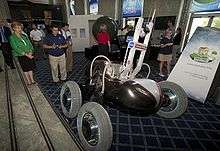
CMU is classified among "R1: Doctoral Universities – Very High Research Activity".[59] For the 2006 fiscal year, the university spent $315 million on research. The primary recipients of this funding were the School of Computer Science ($100.3 million), the Software Engineering Institute ($71.7 million), the College of Engineering ($48.5 million), and the Mellon College of Science ($47.7 million). The research money comes largely from federal sources, with a federal investment of $277.6 million. The federal agencies that invest the most money are the National Science Foundation and the Department of Defense, which contribute 26% and 23.4% of the total university research budget respectively.
The recognition of Carnegie Mellon as one of the best research facilities in the nation has a long history—as early as the 1987 Federal budget CMU was ranked as third in the amount of research dollars with $41.5 million, with only MIT and Johns Hopkins receiving more research funds from the Department of Defense.[60]
The Pittsburgh Supercomputing Center (PSC) is a joint effort between Carnegie Mellon University, University of Pittsburgh, and Westinghouse Electric Company. PSC was founded in 1986 by its two scientific directors, Dr. Ralph Roskies of the University of Pittsburgh and Dr. Michael Levine of Carnegie Mellon University. PSC is a leading partner in the TeraGrid, the National Science Foundation's cyberinfrastructure program.[61]
The Robotics Institute (RI) is a division of the School of Computer Science and considered to be one of the leading centers of robotics research in the world. The Field Robotics Center (FRC) has developed a number of significant robots, including Sandstorm and H1ghlander, which finished second and third in the DARPA Grand Challenge, and Boss, which won the DARPA Urban Challenge. The Robotics Institute has partnered with a spinoff company, Astrobotic Technology Inc., to land a CMU robot on the moon by 2016 in pursuit of the Google Lunar XPrize. The robot, known as Andy, is designed to explore lunar pits, which might include entrances to caves.[62] The RI is primarily sited at Carnegie Mellon's main campus in Newell-Simon hall.[63]
The Software Engineering Institute (SEI) is a federally funded research and development center sponsored by the U.S. Department of Defense and operated by Carnegie Mellon University, with offices in Pittsburgh, Pennsylvania, USA; Arlington, Virginia, and Frankfurt, Germany. The SEI publishes books on software engineering for industry, government and military applications and practices. The organization is known for its Capability Maturity Model[64][65] (CMM) and Capability Maturity Model Integration (CMMI), which identify essential elements of effective system and software engineering processes and can be used to rate the level of an organization's capability for producing quality systems. The SEI is also the home of CERT/CC, the federally funded computer security organization. The CERT Program's primary goals are to ensure that appropriate technology and systems management practices are used to resist attacks on networked systems and to limit damage and ensure continuity of critical services subsequent to attacks, accidents, or failures.[66]
The Human-Computer Interaction Institute (HCII) is a division of the School of Computer Science and is considered one of the leading centers of human-computer interaction research, integrating computer science, design, social science, and learning science.[67] Such interdisciplinary collaboration is the hallmark of research done throughout the university.
The Language Technologies Institute (LTI) is another unit of the School of Computer Science and is famous for being one of the leading research centers in the area of language technologies. The primary research focus of the institute is on machine translation, speech recognition, speech synthesis, information retrieval, parsing and information extraction.[68] Until 1996, the institute existed as the Center for Machine Translation that was established in 1986. From 1996 onwards, it started awarding graduate degrees and the name was changed to Language Technologies Institute.
Carnegie Mellon is also home to the Carnegie School of management and economics. This intellectual school grew out of the Tepper School of Business in the 1950s and 1960s and focused on the intersection of behavioralism and management. Several management theories, most notably bounded rationality and the behavioral theory of the firm, were established by Carnegie School management scientists and economists.
Carnegie Mellon also develops cross-disciplinary and university-wide institutes and initiatives to take advantage of strengths in various colleges and departments and develop solutions in critical social and technical problems. To date, these have included the Cylab Security and Privacy Institute, the Wilton E. Scott Institute for Energy Innovation, the BrainHub, the Simon Initiative, and the Disruptive Healthcare Technology Institute.
Carnegie Mellon has made a concerted effort to attract corporate research labs, offices, and partnerships to the Pittsburgh campus. Apple Inc., Intel, Google, Microsoft, Disney, Facebook, IBM, General Motors, Bombardier Inc., Yahoo!, Uber, Tata Consultancy Services, Ansys, Boeing, Robert Bosch GmbH, and the Rand Corporation have established a presence on or near campus. In collaboration with Intel, Carnegie Mellon has pioneered research into claytronics.[69]
International activities
In addition to its Pittsburgh campus, Carnegie Mellon has a branch campus in the Middle East, Carnegie Mellon University in Qatar, which offers a full undergraduate curriculum with degree programs in computer science, business administration, biology, computational biology, and information systems. The campus is located in Doha's Education City which is home to multiple other U.S. universities all of which are funded by the Qatar Foundation. The Qatari campus has been the subject of criticism due to Qatar's adherence to Sharia Law and lack of freedom of speech and intellectual freedoms.[70] Additionally, Carnegie Mellon and other U.S. Universities in Education City have been criticized for being essentially complicit in Qatar's funding of terrorist groups such as Al Qaeda, ISIS, and Hamas and their questionable human rights record by continuing to operate there despite these issues.[70][71][72][73]
It also has graduate-level extension campuses in Mountain View, California in the heart of Silicon Valley (offering masters programs in Software Engineering and Software Management). The Tepper School of Business maintains a satellite center in downtown Manhattan and the Heinz College maintains one in Adelaide, Australia. The Heinz College, the Institute for Politics and Strategy, and the Department of Engineering and Public Policy host centers in Washington, D.C. as part of degree programs, research, and government affairs initiatives as well as being a part of the University of California, Washington Center. Carnegie Mellon also established the Integrative Media Program at Steiner Studios in Brooklyn, New York. Carnegie Mellon also maintains the Carnegie Mellon Los Angeles Center in North Hollywood, California where students in the Master of Entertainment Industry Management program are required to relocate to Los Angeles in their second year and attend classes at this facility.
Carnegie Mellon's Information Networking Institute offers graduate programs in Athens, Greece and Kobe, Japan, in collaboration with Athens Information Technology and the Hyogo Institute of Information Education Foundation, respectively. In the fall of 2007, the cities of Aveiro and Lisbon, Portugal were added to the Information Networking Institute's remote locations. The Institute for Software Research International (ISRI) offers graduate programs in Coimbra, Portugal. The Entertainment Technology Center offers graduate programs in Portugal, Japan, and Singapore. The Human-Computer Interaction Institute offers a master's degree in conjunction with the University of Madeira, in Portugal at the jointly founded Madeira Interactive Technologies Institute. The College of Engineering has an international location in Kigali, Rwanda offering the Master of Science in Information Technology and the Master of Science in Electrical and Computer Engineering.
In popular culture
The Carnegie Mellon University campus in Pittsburgh has served as the locale for many motion pictures. Alumnus George A. Romero filmed Creepshow (1982) in and around Margaret Morrison Carnegie Hall.[74] Much of the on-campus scenes in the 2000 film Wonder Boys, starring Michael Douglas and Tobey Maguire, were filmed in Carnegie Mellon's campus.[75] Other movies filmed at Carnegie Mellon include The Mothman Prophecies, Dogma, Lorenzo's Oil, Hoffa, The Dark Knight Rises, and Flashdance. The university is also featured prominently in the films Smart People, Monkey Shines, and in the anime Summer Wars. It was also referenced on an episode of The Simpsons, Weeds, and in the television film Mean Girls 2. Carnegie Mellon was identified as the university "Rat" went to in the science fiction film The Core, as well as the university that one of the astronauts attended in the film Deep Impact.[76] In the 2020 Prime Video web series, Upload, as the university Nathan went to for his Computer Engineering degree.
The musical Pippin was originally conceived by Stephen Schwartz as a student musical performed by the Scotch'n'Soda student theatre troupe.[77] Schwartz also collaborated with drama student John-Michael Tebelak to expand his master's thesis project titled Godspell, created under the direction of Lawrence Carra, into a musical.
While enrolled at Carnegie Mellon, acting students Michael McKean and David Lander (class of 1969) created the characters "Lenny & Squiggy". The pair continued performing the characters in live comedy routines before joining the cast of the TV series Laverne and Shirley.
In 2008, Carnegie Mellon professor Randy Pausch's "Last Lecture" became a pop culture phenomenon. Based on a lecture he gave in September 2007 – shortly after he learned his cancer had metastasized – his book quickly rose to the top of bestseller lists around the country. Named in Time Magazine's "Time 100" list of influential people, he died in July 2008 from pancreatic cancer.[78]
In 2003, Carnegie Mellon established the Robot Hall of Fame in partnership with the Carnegie Science Center.
The 68th Tony Awards in 2014 announced Carnegie Mellon University as its first educational partner in jointly awarding the "Tony Honor for Excellence in Theatre Education", which will "honor kindergarten through high school (K-12) theatre educators".[79]
Schools and divisions
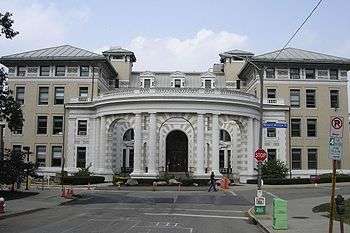
- The College of Engineering includes seven engineering departments (Biomedical Engineering, Chemical Engineering, Civil and Environmental Engineering, Electrical and Computer Engineering, Engineering and Public Policy, Mechanical Engineering, and Materials Science and Engineering), two interdisciplinary institutes (the Information Networking Institute and the Integrated Innovation Institute), and the Engineering Research Accelerator.
- The College of Fine Arts is one of the oldest colleges of fine arts in the United States, and today it is a federation of five distinct schools: The School of Architecture, The School of Music, The School of Design, The School of Drama, and The School of Art. Unlike the other colleges at CMU, where switching between undergraduate programs within the student's currently enrolled college is relatively straightforward, switching to a different school within CFA often requires the student go through an application process similar to that of a High School student.[80][81][82] The college shares research projects, interdisciplinary centers and educational programs with other units across the university.[83] The College of Fine Arts runs masters programs in Arts Management and Entertainment Industry Management with the Heinz College, as well as interdisciplinary undergraduate programs partnered with Dietrich College of Humanities and Social Sciences (BHA), Mellon College of Science (BSA), and the School of Computer Science (SCS).[84]
- The Dietrich College of Humanities and Social Sciences is the university's liberal and professional studies college and emphasizes the study of the human condition through rigorous analysis and technology. Departments include English, History, Modern Languages, Philosophy, Psychology, Social and Decision Sciences and Statistics as well as an Institute for Politics and Strategy. The college also offers undergraduate degree programs in Information Systems, Economics (the latter jointly with the Tepper School of Business), and the Bachelor of Humanities and Arts (BHA) with the College of Fine Arts.[85]
- The H. John Heinz III College of Information Systems and Public Policy offers top-ranked master's degrees in Public Policy and Management, Health Care Policy and Management, Medical Management, Public Management, Information Systems and Management, Information Technology, and Information Security Policy and Management. The Heinz College also runs masters programs in Arts Management and Entertainment Industry Management with the College of Fine Arts. It consists of the School of Information Systems & Management and the School of Public Policy & Management. It also offers several PhD and executive education programs.
- The Mellon College of Science includes four departments: Biological Sciences, Chemistry, Mathematical Sciences and Physics. In addition, the college is expanding efforts in green chemistry, bioinformatics, computational biology, nanotechnology, computational finance, cosmology, sensor research and biological physics. It also offers an undergraduate Bachelor of Science and Arts (BSA) degree in conjunction with the College of Fine Arts.[86]
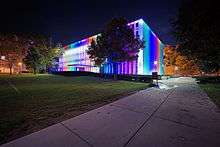
- The School of Computer Science: Carnegie Mellon University helped define, and continually redefines, the field of computer science. The School of Computer Science is recognized internationally as one of the top schools for computer science.[87] The School of Computer Science includes seven departments: the Computer Science Department, Computational Biology Department, Robotics Institute, Machine Learning Department, Institute for Software Research, Human-Computer Interaction Institute, and the Language Technologies Institute. It additionally offers the undergraduate Bachelor of Computer Science and Arts (BCSA) degree in conjunction with the College of Fine Arts.[88]
- The Tepper School of Business offers undergraduate programs in Business Administration and Economics (the latter jointly with the Dietrich College), master's degrees in Business Administration (MBA) and joint degrees in Computational Finance (MSCF) with the Dietrich College of Humanities and Social Sciences, the Mellon College of Science, the Heinz College, and the School of Computer Science. In addition, joint degrees are offered with Civil and Environmental Engineering and the Heinz College. The Tepper School also offers doctoral degrees in several areas and presents a number of executive education programs. Following a $67 million donation from David A. Tepper in 2013, the university sought to expand the undergraduate business program. In summer of 2015, the business program was revamped and a new curriculum was formally instated.[89]
Carnegie Mellon also runs the Integrative Design, Arts, and Technology (IDeATe) Network to provide university-wide arts and technology education to students from every college. IDeATe allows students to take minors or concentrations in Animation and Special Effects, Entrepreneurship for Creative Industries, Game Design, Intelligent Environments, Learning Media, Media Design, Physical Computing, and Sound Design. IDeAte will also offer graduate master's degrees in Emerging Media, Game Design, Integrative Innovation for Products and Services, Computational Data Science, Urban Design, and Production Technology and Management. IDeATe also manages the Entertainment Technology Center (ETC) in conjunction with the School of Computer Science and the College of Fine Arts. Each master's degree program has an option to study in the CMU Integrative Media Program (IMP) at Steiner Studios in New York City. IDeATe Network will be based on the Pittsburgh campus upon the development of recently acquired property on Forbes Avenue west of Junction Hollow.[90]
In addition to research and academic institutions, the University hosts several other educationally driven programs. The Pennsylvania Governor's School for the Sciences, a state-funded summer program that aims to foster interest in science amongst gifted high school students is run on campus every summer. The University also runs Pre-College, a 6-week residential program for rising juniors and seniors in high school, with programs in Drama, Music, Art & Design, Architecture, Game Design & Development, Humanities & Sciences, Mathematics, and Computer Science. The Cyert Center for Early Education is a child care center for Carnegie Mellon faculty and staff, as well as an observational setting for students in child development courses. The Open Learning Initiative provides free courses online in a variety of fields to students globally.
Libraries
Carnegie Mellon University Libraries include Hunt Library, the Roger Sorrells Engineering & Science Library, the Mellon Institute Library, the Posner Center, and the Qatar Library. Additionally, the Libraries' Million Book Project (2001–) sparked development of the Universal Digital Library. The University Libraries host a number of full text special collections for public access, including the Andrew Carnegie Collection, Herbert A. Simon Collection, Allen Newell Collection, the H. John Heinz III Collection, the Pittsburgh Jewish Newspapers Project, and the Posner Memorial Collection. Carnegie Mellon students and faculty have access to the Carnegie Library of Pittsburgh and some University of Pittsburgh libraries through consortial agreements with those institutions. The Hunt Institute for Botanical Documentation (HIBD),[91] dedicated as the Rachel McMasters Miller Hunt Botanical Library in 1961, has been a research division of CMU started as an international bibliographical research and service in the fields of botany, horticulture and the history of the plant sciences, which has a significant research library and art holdings on the 5th floor of Hunt Library. The university's Software Engineering Institute also houses a research library.
Carnegie Mellon also manages the Naval Reserve Officer Training Corps in Pittsburgh on which students throughout Pittsburgh's universities rely. Carnegie Mellon relies on the University of Pittsburgh to provide opportunities in Army Reserve Officers' Training Corps and Air Force Reserve Officer Training Corps to its students.
Carnegie Mellon University is accredited by the Middle States Commission on Higher Education.[92]
Collaboration with the University of Pittsburgh
Carnegie Mellon University neighbors the campus of the University of Pittsburgh, and in some cases, buildings of the two universities are intermingled. This helps to facilitate myriad academic and research collaborations between the two schools,[93] including such projects as the Pittsburgh Supercomputing Center, the Pittsburgh Life Sciences Greenhouse, the Immune Modeling Center, the Center for the Neural Basis of Cognition, the University of Pittsburgh Cancer Institute, as well as the National Science Foundation-supported Pittsburgh Science of Learning Center.[94][95] Further, the universities also offer multiple dual and joint degree programs such as the Medical Scientist Training Program, the Molecular Biophysics and Structural Biology Graduate Program, the Joint CMU-Pitt Ph.D. Program in Computational Biology, the Center for Neural Basis of Cognition, and the Law and Business Administration program. Some professors hold joint professorships between the two schools, and students at each university may take classes at the other (with appropriate approvals).[96] CMU students and faculty also have access to the University of Pittsburgh library system, as well as the Carnegie Library of Pittsburgh. The two universities also co-host academic conferences, such as the 2012 Second Language Research Forum.[97] In 2015, in conjunction with the University of Pittsburgh and UPMC, Carnegie Mellon became a partner of the Pittsburgh Health Data Alliance to leverage data analysis in health care.[98]
Discoveries and innovation
Computer and applied sciences
- Alice (software) – freeware (for non-commercial purposes) object-based educational programming language with an integrated development environment (IDE).[99]
- Andrew Project – distributed computing environment developed at Carnegie Mellon University beginning in 1982. It was an ambitious project for its time and resulted in an unprecedentedly vast and accessible university computing infrastructure. The goal was to have connected 3M computer workstations.[100]
- Artificial intelligence – Several of the first AI software programs were created at Carnegie Mellon. These include the Logic Theorist, General Problem Solver, and Soar.
- Autonomous vehicle – Navlab, the first autonomous car program was developed by Carnegie Mellon. Since then, H1ghlander and Sandstorm autonomous vehicles were developed at Carnegie Mellon and placed 3rd and 2nd in the DARPA Grand Challenge and Carnegie Mellon's Boss won the DARPA Grand Challenge (2007).[101] The university continues to be a leader in autonomous research and development.
- BLISS – system programming language developed at Carnegie Mellon University by W. A. Wulf, D. B. Russell, and A. N. Habermann around 1970. It was perhaps the best known systems programming language until C made its debut in 1972.[102]
- Mach (kernel) – Richard Rashid and Avie Tevanian developed Mach at Carnegie Mellon from 1985 to 1994, ending with Mach 3.0, which is a true microkernel. Mach was developed as a replacement for the kernel in the BSD version of Unix, so no new operating system would have to be designed around it. Experimental research on Mach appears to have ended, although Mach and its derivatives exist within a number of commercial operating systems. These include NeXTSTEP and OpenStep, upon which macOS and iOS are based.[103]
- Wi-fi network – Alex Hills created the first wi-fi network using a local area network (LAN) on the Carnegie Mellon campus in 1993.[104][105]
Companies and entrepreneurship
Carnegie Mellon University's alumni, faculty, and staff have founded many companies, some of which are shown below.[106][107]
- Adobe Systems, 1982, co-founder Charles Geschke (Ph.D.).
- IDEO, 1991, founder and chairman David Kelley (B.S.)
- Appaloosa Management, 1993, co-founder David Tepper (M.B.A).
- Red Hat, 1993, co-founder Marc Ewing (B.S).
- Xerox PARC, 1970, founding director, George Pake (B.S., M.S.)
- Sun Microsystems, 1982, co-founders Vinod Khosla (B.S) and Andy Bechtolsheim (M.S).
- BodyMedia, 1999, co-founder Astro Teller (Ph.D.).
- Cellomics, 1996, founder D. Lansing Taylor (Professor).
- Dansk International Designs, 1974, founder Ted Nierenberg (B.S).
- FORE Systems, 1990, founder Francois Bitz (Professor).
- Activision, 1979, founding CEO Jim Levy (B.S., M.S.)
- Juniper Networks, 1996, founder Pradeep Sindhu (Ph.D.).
- DuoLingo, 2011, founders Luis von Ahn (Ph.D.) & Severin Hacker (Ph.D.).
- Lycos, 1994, founder Michael Loren Mauldin (Ph.D.).
- Vivisimo, 2000, co-founder Raul Valdes-Perez (Professor, Ph.D.).
- Nest, 2010, co-founder Matt Rogers
- Petuum, 2017, founders Eric Xing, Ning Li, Qirong Ho
Alumni and faculty
There are more than 100,000 Carnegie Mellon alumni worldwide with the graduating class of 2015.[108] Alumni and current/former faculty include 20 Nobel laureates, 5 Members of the National Academy of Medicine, 17 Members of the National Academy of Sciences, 57 Members of the National Academy of Engineering, 7 Packard Fellows, 124 Emmy Award recipients (including ten time recipient Steven Bochco), 10 Academy Award recipients, 47 Tony Award recipients, 2 winners of the Stockholm Prize in Criminology, and 13 Turing Award recipients.[13]
Famous alumni include artists Andy Warhol, Philip Pearlstein,[109] John Currin,[110] Shalom Neuman,[111] Jonathan Borofsky[112] and Burton Morris;[113] Authors John-Michael Tebelak and Kurt Vonnegut; Screenwriter Michael Goldenberg, television series creator Steven Bochco,[114] actors René Auberjonois, Holly Hunter, Matt Bomer, and Zachary Quinto, Charles Geschke, Co-Founder and Chairman of Adobe Systems;[115] Stephanie Kwolek, inventor of Kevlar; James Gosling, creator of the Java programming David Edward Byrd, Rock and Broadway Theater Poster Artist and graphic designer[116] language; Andy Bechtolsheim, co-founder of Sun Microsystems; David Kelly, co-founder of IDEO; George Pake, founder of Xerox PARC; Marc Ewing, co-founder of Red Hat; Jim Levy, founding CEO of Activision; former General Motors CEO and Secretary of Defense, Charles Erwin Wilson; Indian film actor Sushma Seth, billionaire hedge fund investor and owner of the Carolina Panthers of the National Football League David Tepper; mountaineer and author Aron Ralston; Scott Fahlman, creator of the emoticon; Chris Messina, creator of the hashtag; and astronauts Edgar Mitchell (of Apollo 14) and Judith Resnik, who perished in the Space Shuttle Challenger disaster.[117] John Forbes Nash, a 1948 graduate and winner of the 1994 Nobel Prize in Economics, was the subject of the book and subsequent film A Beautiful Mind. Alan Perlis, a 1943 graduate, was a pioneer in programming languages and recipient of the first ever Turing award.
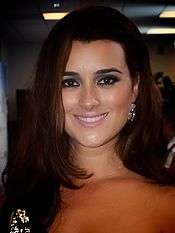 Cote de Pablo, Actress known for NCIS
Cote de Pablo, Actress known for NCIS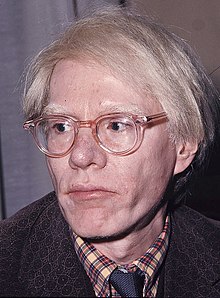 Pop artist Andy Warhol
Pop artist Andy Warhol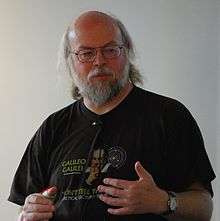 Inventor of Java, James Gosling
Inventor of Java, James Gosling Winner of the 1994 Nobel Prize in Economics John Forbes Nash
Winner of the 1994 Nobel Prize in Economics John Forbes Nash Billionaire hedge fund investor and owner of the Carolina Panthers David Tepper
Billionaire hedge fund investor and owner of the Carolina Panthers David Tepper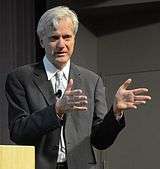 Co-founder of Sun Microsystems Andreas Bechtolsheim
Co-founder of Sun Microsystems Andreas Bechtolsheim Inventor of Kevlar Stephanie Kwolek
Inventor of Kevlar Stephanie Kwolek Former US Secretary of Defense Charles Wilson
Former US Secretary of Defense Charles Wilson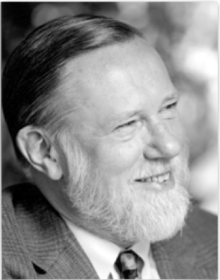 Chairman and co-founder of Adobe Systems Charles Geschke
Chairman and co-founder of Adobe Systems Charles Geschke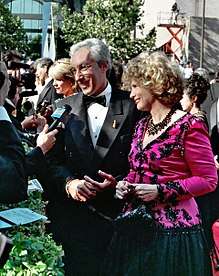 Ten-time Emmy award recipient Steven Bochco
Ten-time Emmy award recipient Steven Bochco Author of "The Last Lecture" Randy Pausch
Author of "The Last Lecture" Randy Pausch
Student life
Carnegie Mellon's student life includes over 225 student organizations, art galleries, and various unique traditions. Student organizations provide social, service, media, academic, spiritual, recreational, sport, religious, political, cultural, and governance opportunities. Carnegie Mellon's campus houses several galleries such as The Frame, a student-devoted gallery, and the Regina Gouger Miller Gallery, an art gallery that specializes in contemporary professional artists. The Carnegie Mellon School of Music, Carnegie Mellon School of Drama and the student-run theatrical organization Scotch'n'Soda provides campus with a variety of performance arts events. The university has a strong Scottish motif inspired by Andrew Carnegie's Scottish heritage, as well as the Mellon family's Scots-Irish ancestry. Examples include Scotty, the Scottish Terrier mascot, The Tartan student newspaper, Skibo Gymnasium, The Thistle yearbook, and the Céilidh weekend every fall semester for homecoming.
Traditions
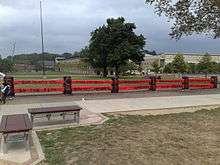
- The Fence – In the early days of Carnegie Tech, there was a single bridge which connected Margaret Morrison Women's College with the Carnegie Institute of Technology. The bridge was a meeting place for students. In 1916, the bridge was taken down and the university filled in the area. The administration built a wooden fence as a new meeting place. The students did not understand why anyone would want to meet at a fence.The administration was about to give up and tear it down, but that night a fraternity, as a prank, painted the entire fence advertising a fraternity party. Ever since, painting the Fence has been a Carnegie Mellon tradition.[118] The Fence at Carnegie Mellon lies at the center of campus, in the area known as "the Cut". Students guard the fence 24 hours a day, and, as long as two vigils are maintained, no other student may "take" the fence. The fence can then be painted by the group that has it, but only between midnight and 6 am. Only hand brushes may be used; the use of spray paint or paint rollers is considered vandalism and results in a fine. The previous paint cannot be stripped, and each new painting adds a new layer. The original wooden fence finally collapsed in the 1990s due to the weight from over 1' of surrounding paint, and was immediately replaced with an identical one manufactured from concrete. Today the fence is considered "the world's most painted object," by the Guinness Book of World Records.
- Spring Carnival – Usually held in April, Spring Carnival is the biggest event of the school year. In addition to classic carnival attractions, the Spring Carnival features the "Buggy Sweepstakes" and "Booth" (a competition between various organizations to build small, elaborate booths based on a theme chosen each year).
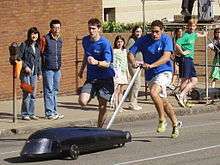
- Buggy Races – Buggy, officially called Sweepstakes, is a race around Schenley Park. It can be thought of as a relay race with five runners, using the buggy vehicle as the baton. Entrants submit a small, usually torpedo-shaped, vehicle that is pushed uphill and then allowed to roll downhill. The vehicles are unpowered, including the prohibition of such energy-storing devices as flywheels. They are, however, steered by a driver who is usually a petite female student lying prone, arms stretched forward to steer via a turning mechanism. Space is so tight inside the buggies that the drivers usually cannot change position beyond turning their heads.

- Mobot – "Mobot,' a portmanteau for "mobile robot," is an annual competition at Carnegie Mellon that made its debut in 1994. In this event, robots try (autonomously) to pass through gates, in order, and reach the finish line. There is a white line on the pavement connecting the gates, and the line is normally used to find the gates, though it is not mandated by the rules that the robots follow the line.
- Bagpipers – As one of only a handful of colleges offering a bachelor's degree in bagpipe music and the only to offer a Masters, Carnegie Mellon University's Pipes and Drums features the sounds of Scottish bagpipes and performs at University events. Director of the Pipes and Drums is champion piper Andrew Carlisle from Northern Ireland, a highly decorated solo piper and longtime member of nine times World Pipe Band Champions Field Marshal Montgomery. The ensemble actively competes at Highland Games in Grade Three in the Eastern United States.
- The Kiltie Band- Carnegie Mellon's Kiltie Band, dressed in full Scottish regalia, including kilts and knee socks, performs during every home football game.
- Autographing the Green Room – Seniors in the College of Fine Arts sign the Green Room's walls and ceilings before leaving the university. Supposedly, Oscar-winning actress Holly Hunter broke university tradition by signing the Green Room during her freshman year. With the construction of the Purnell Center in 1998 the School of Drama no longer occupied the old Green Room, so this tradition has gone away.
Housing
Carnegie Mellon offers conventional housing for its students through single-gender, coeducational, and special interest options. Students can choose from a variety of housing options. The three options for first-year students are standard, prime, and apartment-style living. The Standard is a typical college dormitory setting, a long hallway with a series of double (two people to a room). Prime offers more privacy through suite-style rooms. Apartment-style living is available through the Residence on Fifth and Shirley apartments. Upperclassmen have additional options for housing, which include town houses and a larger variety of one or two bedroom apartments. There are 20 residential buildings on campus and five off campus in the Oakland area of Pittsburgh.[119]
First-year students are assigned to the dedicated first-year residence halls on campus including: Morewood E-Tower, Residence on Fifth, Shirley Apartments, as well as Boss, Donner, Hamerschlag, McGill, Mudge, Scobell, and Stever houses. Approximately a third of upperclassmen choose to continue living on campus through university housing. Options for upperclassmen include: Morewood Gardens, West Wing, Doherty, Fairfax, Margaret Morrison, Neville, Shady Oak, Shirley, and Woodlawn Apartments as well as Henderson, Resnik, Roselawn, Spirit, Tech, Webster, and Welch houses.[119]
Fraternities and sororities
The Greek tradition at Carnegie Mellon University began over 100 years ago with the founding of the first fraternity on campus, Theta Xi, in 1912. The Panhellenic sorority community was founded in 1945, by Chi Omega, Delta Delta Delta, Delta Gamma, Kappa Alpha Theta, and Kappa Kappa Gamma. The Chi Omega chapter at Carnegie Mellon transformed into an independent sorority, Zeta Psi Sigma, and has since become Alpha Chi Omega. The Alpha Phi chapter was created in April 2013. There is one Asian American interest sorority – alpha Kappa Delta Phi (colony), and one Asian American interest fraternity – Lambda Phi Epsilon.
Currently, Carnegie Mellon University has thirteen active fraternities: Alpha Epsilon Pi, Alpha Phi Alpha, Alpha Tau Omega (colony), Alpha Sigma Phi, Delta Tau Delta, Kappa Sigma, Lambda Phi Epsilon, Phi Delta Theta, Pi Kappa Alpha, Sigma Alpha Epsilon, Sigma Chi, Sigma Nu, and Sigma Phi Epsilon.
In addition to participating in campus traditions such as Buggy and Booth, the fraternities and sororities hold an annual fundraiser called Greek Sing, one of the largest Greek events of the year. Each year, the organizations vote on a cause to support and raise money through ticket sales, ad sales, corporate sponsorships and donations. Each organization performs a 13-minute-long original show or a rendition of a popular show. In Spring 2010, Greek Sing raised over $42,000 for St. Jude Children's Research
Athletics
The Carnegie Mellon Tartans were a founding member of the University Athletic Association of NCAA Division III. Prior to World War II Carnegie Mellon (as Carnegie Tech) played with NCAA Division I teams. In 1936, the Carnegie Tech riflery team won the national intercollegiate championship.[120] Currently, varsity teams are fielded in basketball, track, cross country, football, golf, soccer, swimming & diving, volleyball, tennis, hockey, and rowing. In addition, club teams exist in ultimate frisbee,[121] rowing,[122] rugby, lacrosse, hockey,[123] baseball,[124] softball, skiing & snowboarding,[125] soccer, volleyball, water polo,[126] and cycling.[127] Carnegie Mellon Athletics runs a comprehensive and popular intramural system, maintains facilities (primarily Skibo Gymnasium, Cohon University Center, and Gesling Stadium), and offers courses to students in fitness and sports. Carnegie Mellon's primary athletic rivals are fellow UAA schools Case Western Reserve University and Washington University in St. Louis; the Tartans had an especially intense rivalry with the latter's football team from the 2000s to 2017.

Football
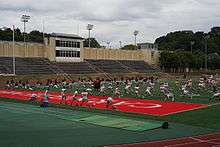
On November 28, 1926, the 6–2 Carnegie Technical Institute football team shut out the undefeated Notre Dame Fighting Irish 19–0 at Forbes Field. Knute Rockne, the coach of the Irish at the time, was so confident that the Irish would defeat "tiny Carnegie Tech" that he decided to skip the game and travel to Chicago to watch the Army-Navy football game for scouting purposes. It was only later that he found out by telegram that the Irish had suffered their first loss of the season. ESPN compared the upset to the Appalachian State victory over the University of Michigan in 2007.[128] The game was ranked the fourth-greatest upset in college football history by ESPN.[129]
Since 2014, the Tartans play in the Presidents' Athletic Conference at the NCAA Division III level. The head coach of the football team is Rich Lackner, 210-114-2 (32) at CMU.
Track and cross country
In recent years, the varsity track and cross country programs have seen outstanding success on the Division III national level. The men's cross country team has finished in the top 15 in the nation each of the last three years, and has boasted several individual All-Americans. The men's track team has also boasted several individual All-Americans spanning sprinting, distance, and field disciplines. Recent All-Americans from the track team are Tommy Vandenberg (2014–2015), Brian Harvey (2007–2009), Davey Quinn (2007), Nik Bonaddio (2004, 2005), Mark Davis (2004, 2005), Russel Verbofsky (2004, 2005) and Kiley Williams (2005).[130] Carolyn Lowe (10,000 meters 1992) is the only track athlete to win an NCAA Division III championship.
Volleyball
With much of the team's support, Lauren Schmidt received the NCAA Pennsylvania Woman of the Year award (2003), was a two-time All-American (2001 and 2002), a four-time All-University Athletic Association selection (1999–2002), and the conference's Player of the Year (2001).[131]
Cricket
The Carnegie Mellon Cricket Club represents Carnegie Mellon in intercollegiate competitions. CMU cricket clubs are regular participants in the American College Cricket national championships. CMU were joint-runners up in the first-ever American College Cricket Tournament held in Florida in Spring 2009.[132]
Intramurals
The Carnegie Mellon student culture has facilitated the growth of a robust intramural sporting community. Students can participate in any level of competition across multiple sports including wiffle ball, dodgeball, basketball, flag football, ultimate frisbee and many more.[133]
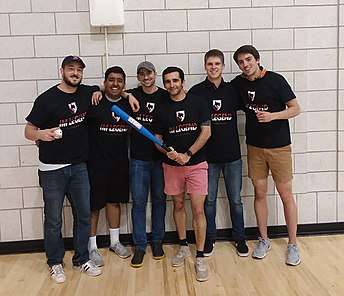
Student resources
CMU Food Pantry
In October 2017, Carnegie Mellon took part in a study conducted by the University of Pittsburgh's Office of Child Development that examined food insecurity among students. The results from the CMU survey demonstrated that 19% of student respondents felt some sense of food insecurity, which is defined by the study as "a lack of consistent access to enough food for an active, healthy life."[134] In an effort to address the need for food security, CMU opened the doors to an on-campus pantry on November 9, 2018.
The pantry gives visitors the opportunity to pick up non-perishables and fresh produce for their household free of charge every two weeks. The pantry is accessible to all graduate and undergraduate CMU students, and is located in the Residence on Fifth dormitory in Oakland.
See also
Notes and references
- As of June 30, 2019. "U.S. and Canadian 2019 NTSE Participating Institutions Listed by Fiscal Year 2019 Endowment Market Value, and Percentage Change in Market Value from FY18 to FY19 (Revised)". National Association of College and University Business Officers and TIAA. Retrieved April 21, 2020.
- Walters, Ken (January 20, 2015). "James Rohr To Become Chairman of Carnegie Mellon's Board of Trustees". Carnegie Mellon University.
- "CMU Fact Sheet" (PDF). cmu.edu. March 2020. Archived (PDF) from the original on April 21, 2020. Retrieved April 21, 2020.
- "Carnegie Mellon Common Data Set 2019-2020" (PDF). Carnegie Mellon University. Archived (PDF) from the original on December 12, 2019. Retrieved December 12, 2019.
- "About the Tepper School Carnegie Mellon Campus". Tepper School of Business. Archived from the original on February 15, 2017. Retrieved February 15, 2017.
- "2015–2016 Undergraduate Catalog: Department of Athletics and Physical Education". Carnegie Mellon University. Archived from the original on October 13, 2015. Retrieved October 15, 2015.
- "Carnegie Mellon's Mascot". Archived from the original on May 3, 2009. Retrieved September 20, 2009.
- "History - CMU - Carnegie Mellon University". Carnegie Mellon University. Archived from the original on September 3, 2018. Retrieved September 4, 2018.
- "Carnegie Mellon University's Global Presence". Carnegie Mellon University. Archived from the original on September 4, 2018. Retrieved September 4, 2018.
- "Academics - CMU - Carnegie Mellon University". Carnegie Mellon University. Archived from the original on September 4, 2018. Retrieved September 4, 2018.
- "Interdisciplinary Programs - CMU - Carnegie Mellon University". Carnegie Mellon University. Archived from the original on September 3, 2018. Retrieved September 4, 2018.
- "CMU Fact Sheet" (PDF). Carnegie Mellon University. March 2020. Archived (PDF) from the original on April 21, 2020. Retrieved April 21, 2020.
- "Awards - CMU - Carnegie Mellon University". Carnegie Mellon University. Archived from the original on September 9, 2016. Retrieved September 4, 2016.
- Committee on Education, United States House of Prepresentatives (1920). Charges Against the Federal Board for Vocational Education, Volume 3. Washington: Government Printing Office. Retrieved June 25, 2015.
- "Boston Evening Transcript – Google News Archive Search". google.com. Archived from the original on May 12, 2016. Retrieved November 5, 2015.
- "Mellon Institute at Carnegie Mellon University National Historic Chemical Landmark". American Chemical Society. Archived from the original on November 14, 2017. Retrieved July 16, 2019.
- "History of MMCC". carnegiemellontoday.com. Archived from the original on February 21, 2009. Retrieved February 15, 2008.
- "CMU closing its Carnegie Mellon Research Institute". post-gazette.com. Archived from the original on October 4, 2013. Retrieved October 1, 2013.
- "CMU student center to be renamed for Cohon". Pittsburgh Post-Gazette. 2014. Archived from the original on March 26, 2014. Retrieved March 25, 2014.
- "The Tartan reflects on the people and events of 2005–2006". The Tartan. 2006. Archived from the original on January 14, 2009. Retrieved January 7, 2009.
- "CMU proposes hotel, office, retail complex to help remake Forbes Avenue". The Pittsburgh Post-Gazette. 2015. Archived from the original on April 24, 2015. Retrieved April 23, 2015.
- "Randy Pausch's Last Lecture: Really Achieving Your Childhood Dreams" (PDF). Randy Pausch. Archived (PDF) from the original on May 13, 2008. Retrieved May 7, 2008.
- World's Best Universities; Top 400 Universities in the World Archived September 6, 2013, at the Wayback Machine. US News. Retrieved on July 17, 2013.
- QS World University Rankings – 2012 Archived September 13, 2012, at the Wayback Machine. Top Universities (December 19, 2012). Retrieved on July 17, 2013.
- "The Top 200 World Universities". timeshighereducation.com. Archived from the original on January 15, 2008. Retrieved February 18, 2008.
- Inspire Innovation: About the Campaign – Carnegie Mellon Web Site. Archived November 30, 2009, at the Wayback Machine. Retrieved September 11, 2011.
- "Bill Dietrich & Carnegie Mellon University".
- "Retrieved September 20, 2012". Cmu.edu. Archived from the original on June 25, 2014. Retrieved June 19, 2014.
- "Heinz Endowments Gift". Carnegie Mellon University. Archived from the original on December 13, 2013. Retrieved December 12, 2013.
- "Retrieved November 15, 2013". Cmu.edu. November 14, 2013. Archived from the original on March 20, 2016. Retrieved June 19, 2014.
- "Retrieved August 25, 2015". Cmu.edu. August 25, 2015. Archived from the original on August 28, 2015. Retrieved August 25, 2015.
- "Retrieved February 5, 2013". Cmu.edu. February 5, 2013. Archived from the original on December 15, 2014. Retrieved June 19, 2014.
- "Suresh To Step Down as President of Carnegie Mellon University - News - Carnegie Mellon University". Carnegie Mellon University. June 1, 2017. Archived from the original on September 4, 2018. Retrieved September 4, 2018.
- "Farnam Jahanian Named President of Carnegie Mellon University - News - Carnegie Mellon University". Carnegie Mellon University. March 8, 2018. Archived from the original on March 21, 2018. Retrieved September 4, 2018.
- "Academic Ranking of World Universities 2020: National/Regional Rank". Shanghai Ranking Consultancy. Retrieved August 15, 2020.
- "America's Top Colleges 2019". Forbes. Retrieved August 15, 2019.
- "U.S. College Rankings 2020". Wall Street Journal/Times Higher Education. Retrieved September 26, 2019.
- "Best Colleges 2020: National University Rankings". U.S. News & World Report. Retrieved September 8, 2019.
- "2019 National University Rankings". Washington Monthly. Retrieved August 20, 2019.
- "Academic Ranking of World Universities 2020". Shanghai Ranking Consultancy. 2020. Retrieved August 15, 2020.
- "QS World University Rankings® 2021". Quacquarelli Symonds Limited. 2020. Retrieved June 10, 2020.
- "World University Rankings 2020". THE Education Ltd. Retrieved September 14, 2019.
- "Best Global Universities Rankings: 2020". U.S. News & World Report LP. Retrieved October 22, 2019.
- "Carnegie Mellon University: Best Colleges Rankings". U.S. News & World Report. Archived from the original on May 24, 2019. Retrieved December 9, 2019.
- "U.S. News Best Grad School Rankings". U.S. News & World Report. Archived from the original on May 15, 2019. Retrieved December 9, 2019.
- "Americas 25 New Elite Ivies". newsweek.com. August 21, 2006. Archived from the original on July 14, 2011. Retrieved August 21, 2010.
- "The Top 25 Recruiter Picks". Wall Street Journal. September 13, 2010. Archived from the original on December 26, 2014. Retrieved August 3, 2017.
- "Best Universities and Colleges | Payscale". www.payscale.com. Archived from the original on December 23, 2016. Retrieved December 20, 2016.
- "Best Business Schools 2018 US Rankings - Bloomberg Businessweek". Bloomberg.com. Archived from the original on April 16, 2019. Retrieved October 7, 2019.
- "The 25 Best Drama Schools in 2016". The Hollywood Reporter. Archived from the original on May 23, 2016. Retrieved June 2, 2014.
- "The 25 Best Drama Schools for a Master of Fine Arts". The Hollywood Reporter. Archived from the original on May 30, 2015. Retrieved May 29, 2015.
- "Carnegie Mellon University – Computer Ranking 2015". Archived from the original on July 26, 2013. Retrieved October 20, 2016.
- "Subject Ranking 2020: Social Sciences". Times Higher Education (THE). Archived from the original on December 10, 2019. Retrieved December 23, 2019.
- "Subject Ranking 2020: Arts and Humanities". Times Higher Education (THE). Archived from the original on December 10, 2019. Retrieved December 23, 2019.
- "Rankings". Carnegie Mellon University. Archived from the original on November 29, 2019. Retrieved April 13, 2016.
- "Global University Leaders Forum 2015 Members List" (PDF). World Economic Forum. Archived (PDF) from the original on September 6, 2015. Retrieved August 11, 2015.
- "Carnegie Mellon Common Data Set 2019-2020" (PDF). Carnegie Mellon University. Archived (PDF) from the original on December 12, 2019. Retrieved December 12, 2019.
- "General Fact Sheet" (PDF). Carnegie Mellon Undergraduate Admissions. Archived (PDF) from the original on December 12, 2019. Retrieved December 12, 2019.
- "Carnegie Classifications - Institution Profile". Indiana University Center for Postsecondary Research. Retrieved March 30, 2020.
- "CMU Is Third in Defense Contracts". Pittsburgh Post-Gazette. May 25, 1988. Archived from the original on May 5, 2016. Retrieved November 5, 2015 – via Google News Archive.
- "Pittsburgh Supercomputing Center". Pittsburgh Supercomputing Center. Archived from the original on February 8, 2008. Retrieved February 18, 2008.
- "Carnegie Mellon Lunar Rover Wows XPRIZE Judges, Wins First Milestone Prize for Development Toward Flight Readiness – Carnegie Mellon School of Computer Science". December 16, 2014. Archived from the original on October 20, 2016. Retrieved October 20, 2016.
- "Robotics Institute". Robotics Institute. Archived from the original on October 24, 2007. Retrieved February 18, 2008.
- Paulk, Mark C.; Weber, Charles V; Curtis, Bill; Chrissis, Mary Beth (February 1993). "Capability Maturity Model for Software (Version 1.1)" (PDF). Technical Report. Software Engineering Institute, Carnegie Mellon University. CMU/SEI-93-TR-024 ESC-TR-93-177. Archived (PDF) from the original on November 5, 2013. Retrieved May 13, 2013.
- Paulk, Mark C.; Weber, Charles V; Curtis, Bill; Chrissis, Mary Beth (1995). The Capability Maturity Model: Guidelines for Improving the Software Process. SEI series in software engineering. Addison-Wesley. ISBN 0-201-54664-7.
- "Software Engineering Institute". sei.cmu.edu. Archived from the original on December 3, 2009. Retrieved February 16, 2008.
- "Welcome to the Human-Computer Interaction Institute". Human-Computer Interaction Institute. Archived from the original on May 9, 2008. Retrieved February 18, 2008.
- "CMU/Language Technologies Institute". Language Technologies Institute. Archived from the original on December 16, 2008. Retrieved December 24, 2008.
- "The Claytronics Project – Collaborative Research in Programmable Matter Directed by Carnegie Mellon and Intel". Cs.cmu.edu. February 20, 2007. Archived from the original on June 22, 2014. Retrieved June 19, 2014.
- "In Qatar's Education City, U.S. colleges are building an academic oasis". Archived from the original on March 5, 2016. Retrieved October 27, 2016.
- Stoltzfus, Justin. "Advocate questions motive behind Qatar's financial ties to U.S. colleges". Gulf News Journal. Archived from the original on April 18, 2016. Retrieved October 27, 2016.
- "While U.S. universities see dollar signs in Qatari partnerships, some cry foul". Gulf News Journal. Archived from the original on October 4, 2015. Retrieved October 27, 2016.
- "Hate Preachers on Qatar Campus: Obama Gives Qatar Undeserved A+ on Fighting Incitement". The Huffington Post. April 29, 2016. Archived from the original on October 22, 2016. Retrieved October 27, 2016.
- "Alumnus Gets Star Treatment | Carnegie Mellon Today". cmtoday.cmu.edu. Archived from the original on February 2, 2017. Retrieved January 23, 2017.
- "Major Motion Picture, "Smart People," To Be Filmed on Campus". www.cmu.edu. Archived from the original on June 4, 2016. Retrieved January 23, 2017.
- "Carnegie Mellon on "The Simpsons" and "Lie to Me"- Carnegie Mellon University". Cmu.edu. February 16, 2009. Archived from the original on January 14, 2010. Retrieved February 22, 2010.
- Holahan, Jane (December 7, 2006). "Creator on 'Pippin:' 'It was an inventive time'". Lancaster Online. Archived from the original on September 12, 2007. Retrieved December 30, 2006.
- Couric, Katie (April 30, 2009). "Randy Pausch – The 2008 TIME 100". TIME. Archived from the original on June 6, 2012. Retrieved February 22, 2010.
- Gans, Andrew. "Zachary Quinto and Matt Bomer Will Introduce New Educator Honor at 2014 Tony Awards" Archived July 14, 2014, at the Wayback Machine playbill.com, June 3, 2014
- "Transfer Students". Undergraduate Admission Requirements. School of Drama. July 31, 2016. Archived from the original on February 8, 2011.
- "Regular Decision & Transfer". Undergraduate Admissions. School of Architecture. July 31, 2016. Archived from the original on July 9, 2016.
- "Transfer Applications". Application Instructions & Timeline. School of Design. July 31, 2016. Archived from the original on August 7, 2016.
- "BXA Intercollege Degree Programs". CMU College of Fine Arts. July 31, 2016. Archived from the original on August 7, 2016.
- "BXA Intercollege Degree Programs – The Programs". www.cmu.edu. Archived from the original on October 2, 2017. Retrieved February 7, 2018.
- "BXA Intercollege Degree Programs – BHA Program". www.cmu.edu. Archived from the original on February 7, 2018. Retrieved February 7, 2018.
- "BXA Intercollege Degree Programs – BSA Program". www.cmu.edu. Archived from the original on February 7, 2018. Retrieved February 7, 2018.
- "America's Best Graduate Schools 2009". U.S. News & World Report. Archived from the original on October 11, 2007. Retrieved March 28, 2008.
- "BXA Intercollege Degree Programs – BCSA Program". www.cmu.edu. Archived from the original on February 7, 2018. Retrieved February 7, 2018.
- "UBA Curriculum Change". Carnegie Mellon University. Archived from the original on September 25, 2015.
- "Integrative Design, Arts, and Technology". Carnegie Mellon University. Archived from the original on January 17, 2014. Retrieved January 17, 2014.
- "Home : Hunt Institute". Hunt Institute for Botanical Documentation. Archived from the original on May 9, 2008. Retrieved May 21, 2018.
- "Middle States Accreditation – Carnegie Mellon University". Carnegie Mellon University. Archived from the original on July 23, 2013. Retrieved January 26, 2013.
- Schackner, Bill; Chute, Eleanor (March 29, 2012). "Pitt, CMU make most of proximity". Pittsburgh Post-Gazette. Pittsburgh, PA. Archived from the original on April 6, 2013. Retrieved May 21, 2012.
- University of Pittsburgh: Undergraduate Admissions & Financial Aid Archived January 19, 2012, at the Wayback Machine. Pitt.edu. Retrieved on July 17, 2013.
- "Welcome". Pittsburgh Science of Learning Center. Archived from the original on December 5, 2011. Retrieved December 2, 2011.
- "Cross Registration". Pittsburgh Council on Higher Education. Retrieved December 2, 2011.
- "SLRF 2012 in Pittsburgh". SLRF 2012 Organizing Committee. Archived from the original on January 19, 2012. Retrieved December 2, 2011.
- "Three Pittsburgh institutions. One goal". Pittsburgh Health Data Alliance. Archived from the original on March 13, 2015. Retrieved March 16, 2015.
- "Alice.org". Archived from the original on May 20, 2017. Retrieved January 31, 2020.
- CMU's overview of the history of the Andrew Project Archived July 17, 2012, at the Wayback Machine
- "Carnegie Mellon University – University Discoveries". Archived from the original on October 26, 2016. Retrieved October 25, 2016.
- "The BLISS programming language: a history" (PDF). Archived (PDF) from the original on April 11, 2019. Retrieved August 27, 2019.
- McKusick, Marshall Kirk; Bostic, Keith; Karels, Michael J.; Quarterman, John S. (April 30, 1996). The Design and Implementation of the 4.4 BSD Operating System. Addison-Wesley. p. 123. ISBN 978-0-7686-8494-0.
- "How Wi-Fi got its start on the campus of CMU, a true story". Archived from the original on December 2, 2016. Retrieved October 25, 2016.
- University, Carnegie Mellon. "Alex Hills-Engineering and Public Policy – Carnegie Mellon University". Archived from the original on October 26, 2016. Retrieved October 25, 2016.
- University, Carnegie Mellon. "Affiliated Companies-Corporate and Institutional Partnerships – Carnegie Mellon University". www.cmu.edu. Archived from the original on December 1, 2017. Retrieved November 25, 2017.
- "CMU Alumni" (PDF). Archived from the original (PDF) on October 19, 2017.
- "We Are 100K Strong!". Archived from the original on January 9, 2016. Retrieved December 31, 2015.
- "Carnegie Museum of Art". collection.cmoa.org. Archived from the original on November 7, 2017. Retrieved August 26, 2018.
- "John Currin at Gagosian". www.gagosian.com. April 12, 2018. Archived from the original on August 30, 2017. Retrieved September 11, 2017.
- Higgins, Tim. "New York 'Fusion' artist Shalom Neuman brings philosophy to Easton". Archived from the original on September 8, 2017. Retrieved September 10, 2017.
- "Jonathan Borofsky Interview – Carnegie Mellon Today". cmtoday.cmu.edu. Archived from the original on September 14, 2017. Retrieved September 14, 2017.
- "Burton Morris: The King of Pop Art Hits the "Red Carpet"". Archived from the original on May 2, 2019. Retrieved February 13, 2013.
- University, Carnegie Mellon. "News - College of Fine Arts - Carnegie Mellon University". cms-staging.andrew.cmu.edu. Archived from the original on July 24, 2019. Retrieved May 15, 2019.
- "Notable Alumni". Archived from the original on December 18, 2015. Retrieved November 19, 2015.
- davidedwardbyrd.com
- "Judy Resnik : Family, Friends Remember Engineer Who Reached for the Stars". Archived from the original on January 31, 2016. Retrieved February 7, 2016.
- "Walking Tour". cmu.edu. Archived from the original on May 16, 2008. Retrieved February 18, 2008.
- "CMU Housing". Carnegie Mellon University. Archived from the original on July 24, 2011. Retrieved July 26, 2011.
- "Intercollegiate rifle team trophy" (PDF). Archived (PDF) from the original on September 1, 2009. Retrieved September 5, 2009.
- "Carnegie Mellon Ultimate Club". cmu.edu. Archived from the original on April 30, 2007. Retrieved February 18, 2008.
- "Tartan Crew". tartancrew.org. Archived from the original on March 11, 2008. Retrieved February 18, 2008.
- "CMU Ice Hockey Club". Archived from the original on February 1, 2011. Retrieved February 18, 2008.
- "Join the Baseball Club". cmu.edu. Archived from the original on May 13, 2008. Retrieved February 18, 2008.
- "Club Sports – Carnegie Mellon University Athletics". Athletics.cmu.edu. Archived from the original on June 7, 2014. Retrieved June 19, 2014.
- "CMUWP". cmuwp. Archived from the original on June 26, 2009. Retrieved August 25, 2009.
- "Carnegie Mellon Cycling Club". cmu.edu. Archived from the original on September 5, 2008. Retrieved February 18, 2008.
- "Tech's Greatest Victory". carnegiemellontoday.com. Archived from the original on March 17, 2008. Retrieved February 18, 2008.
- "Upset special: With Rockne gone, Irish took a Michigan-like tumble". sports.espn.go.com. Archived from the original on November 6, 2013. Retrieved February 18, 2008.
- CMU.edu
- Wellsville Central Schools – Scrapbook Archived September 29, 2011, at the Wayback Machine. Wellsville.wnyric.org (August 30, 2012). Retrieved on July 17, 2013.
- "About". CMU Cricket. Archived from the original on December 12, 2010. Retrieved June 19, 2014.
- "Intramurals". Retrieved February 23, 2020.
- University, Carnegie Mellon (November 8, 2018). "Open for Business: CMU Pantry aims to reduce student food insecurity on campus - Student Government - Carnegie Mellon University". www.cmu.edu. Archived from the original on February 12, 2019. Retrieved February 11, 2019.
External links
| Wikisource has the text of the 1920 Encyclopedia Americana article Carnegie Technical Schools. |
| Wikimedia Commons has media related to Carnegie Mellon University. |


